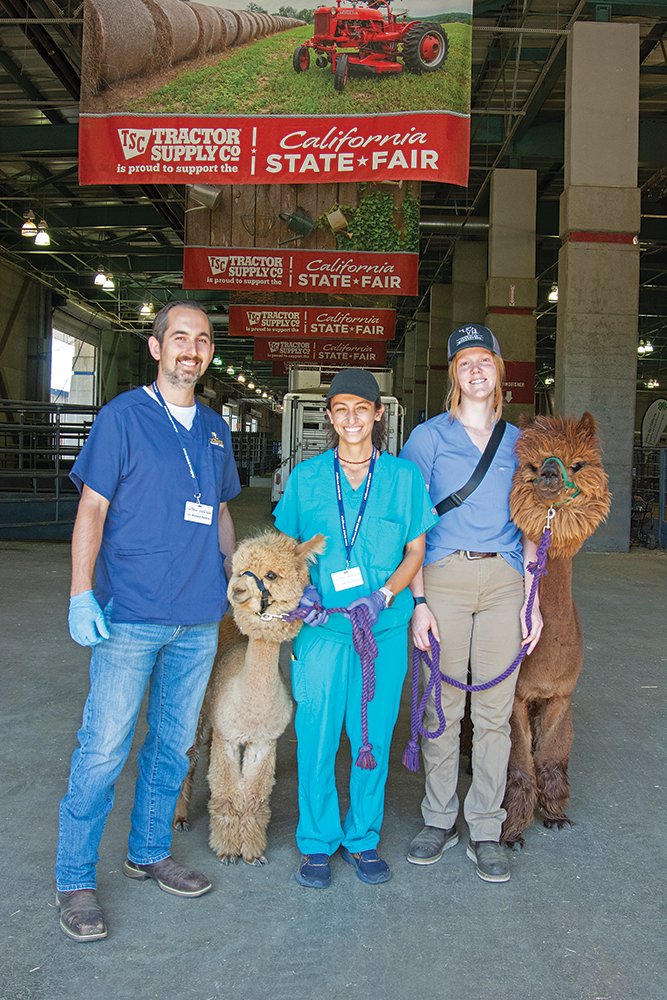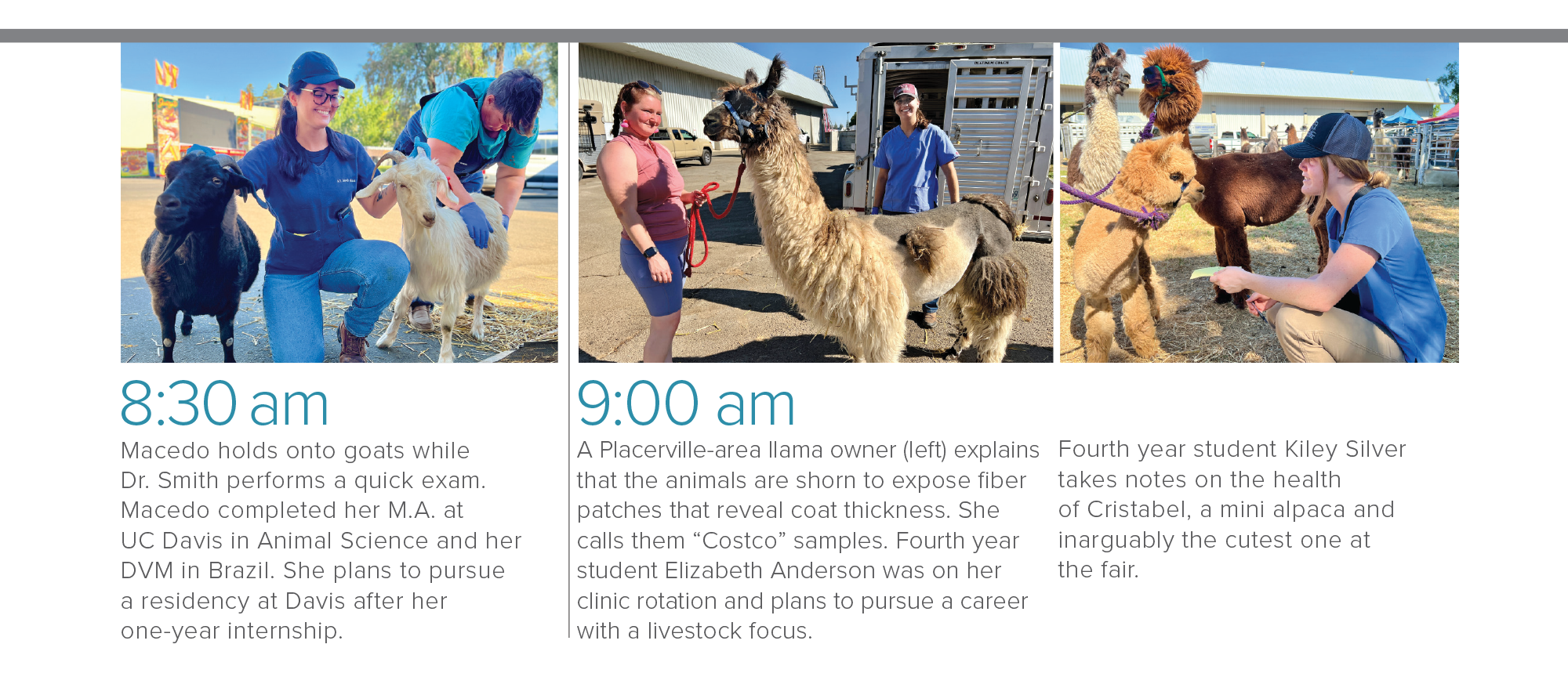
A Day at the Fair
For nearly 50 years, teams of UC Davis veterinarians and students-in-training have helped monitor the health and wellbeing of hundreds of animals brought to the California State Fair.

From sheep, goats and camelids to longhorn beef and dairy cattle, the Livestock Herd Health and Reproduction Service ensures that each animal who comes for exhibit or competition undergoes a general physical check and receives any needed veterinary care during the course of the 17-day annual event. The team also conducts drug-residue collection and analysis on any food animal winners for medical drug residues.
While the service provides both in-house and ambulatory services to dairies, ranches, and breeding operations within the greater Davis area, serving the state fair is a long tradition and partnership. For Dr. Fauna Smith DVM ’05, Ph.D. ’22, assistant professor of Livestock Reproduction and Herd Health, the fair has been a touchstone of her relationship with UC Davis.
As an 8-year-old, Smith recalls UC Davis veterinary students checking in the goats she brought to the fair from her hometown in Mendocino County. As a veterinary student, she managed the birthing exhibit (that has since been discontinued). After living and working in New Zealand for 10 years in mixed large and equine medicine practice, Smith returned to UC Davis for an equine internal medicine residency and a Ph.D. before taking her current position previously held by her mentor, Dr. Joan Dean Rowe, for 30 years. Her first day on the job started in July 2022—at the state fair.
One of biggest differences in being a livestock vet is that it’s one professional dealing with another. It’s more of a partnership in caring for their animals.”
—Dr. Fauna Smith
“One of biggest differences in being a livestock vet is that it’s one professional dealing with another,” said Smith, who maintains a herd of Nubian dairy goats. “Our clients are professionals in their own right running a farm. It’s more of a partnership in caring for their animals and helping someone doing their job for a living. To me, that’s what’s appealing.”
Some are multigenerational farming families and others are venturing into animal production for the first time.
Even though much of the team’s job focuses on wellness through herd health and reproduction, they deal with four different species (cattle, sheep, goats and swine). Within those, there is huge variety in the use of the animals: fiber, milk and meat production; targeted grazing; high genetic value stock, etc. Their clients are also diverse, ranging from large operations with several thousand animals, to small seed stock producers, to small diversified farms. Some are multigenerational farming families and others are venturing into animal production for the first time.
“Everyone has different needs and wants and that keeps you on your toes,” she said. “You have to think about all the different aspects that may be important for that particular client.”
Everyone has different needs and wants and that keeps you on your toes.”
—Dr. Fauna Smith
Article continues after images.
![[Timeline of the day] 8:00am: Fair exhibitors unload their Dorper sheep so Dr. Isabelle Macedo can get a better look. Dr. Fauna Smith examines a sheep’s eyes and ears. All animals brought to the state fair for exhibit or competition undergo a health check by the team to ensure they don’t transmit disease to other animals or humans.](/sites/g/files/dgvnsk8541/files/media/images/fair-timeline1.png)


The variety of species and sheer number of animals seen over the course of the state fair (more than 3,000) provides a perfect training ground for DVM students, residents and interns.
They are working at the interface between herd health and public health as many of the diseases the team screens for are zoonotic, meaning they are able to transmit between animals and humans. With thousands of people that walk through the exhibits each day, wanting to touch the animals and interact with them, it’s critical to ensure that the animals are healthy when they arrive.
In addition to disease screening or basic treatment and triage, the team also identifies animals that need further care than can be provided on site. This year, there was a dairy cow that Dr. Bret McNabb stabilized in the field and had transported. She needed a blood transfusion and tested positive for anaplasmosis.
That’s not an uncommon story, Smith said. As a senior student, she sent a cow in difficult labor to the veterinary hospital to be treated by the Internal Medicine service. The cow had a uterine torsion, but thanks to the hospital team, she delivered live healthy twin heifer calves and fully recovered.


Another challenge is that the animals are coming from 60 to 70 herds across the state, each with their own milieu of pathogens, flora and fauna on their farms. Lessons about disease transmission are important for students and residents as they practice the ability to quickly and efficiently recognize problems. Because the animals aren’t receiving a full physical exam as they are unloaded from trailers, Smith and other faculty members teach students, residents, and interns how to look over animals and pick out obvious issues that may need a closer look.
My job is to keep my eyes and ears open to what else is happening on the farm, and if I see things that could be problems, address those. You need to train your brain to take in everything you’re seeing.”
—Dr. Fauna Smith
“When you’re on a farm, dealing with animals, we do a lot of that,” Smith said. “When I go to a farm for a pregnancy scan, my job isn’t just to do what I’m asked to do. My job is to keep my eyes and ears open to what else is happening on the farm, and if I see things that could be problems, address those. You need to train your brain to take in everything you’re seeing. The fair is where students get the most amount of that experience in a short period of time.”
To contact the Livestock Herd Health and Reproduction Team for an appointment, call 530-752-0290.
